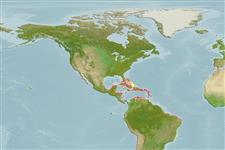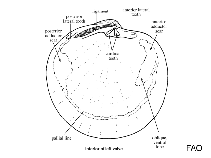Lucina pectinata (Gmelin, 1791)
Thick lucine| Native range | All suitable habitat | Point map | Year 2050 |

|
| This map was computer-generated and has not yet been reviewed. |
| Lucina pectinata AquaMaps Data sources: GBIF OBIS |
Upload your photos
Google image | No image available for this species;
drawing shows typical species in Lucinidae.
Google image | No image available for this species;
drawing shows typical species in Lucinidae.
Classification / Names Common names | Synonyms | CoL | ITIS | WoRMS
Bivalvia | Lucinida | Lucinidae
Environment: milieu / climate zone / depth range / distribution range Ecology
Benthic; brackish; depth range 0 - 2 m (Ref. 87155). Subtropical; 27°C - 28°C (Ref. 87155); 36°N - 29°S, 98°W - 34°W
Distribution Countries | FAO areas | Ecosystems | Occurrences | Introductions
Western Atlantic: Canada to North Carolina, Florida, Texas, West Indies, Venezuela, Suriname, Brazil (Amapa to Santa Catarina).
Length at first maturity / Size / Weight / Age
Maturity: Lm 3.0 range ? - ? cm
Depth range from Belize (Ref. 87155). Minimum depth based on its ecology (Ref.104470).
Life cycle and mating behavior Maturity | Reproduction | Spawning | Eggs | Fecundity | Larvae
Life cycle: Embryos develop into free-swimming trocophore larvae, succeeded by the bivalve veliger, resembling a miniature clam (Ref. 833).
Main reference
References | Coordinator | Collaborators
Turgeon, D.D., J.F. Quinn Jr., A.E. Bogan, E.V. Coan, F.G. Hochberg, W.G. Lyons, P.M. Mikkelsen, R.J. Neves, C.F.E. Roper, G. Rosenberg, B. Roth, A. Scheltema, F.G. Thompson, M. Vecchione and J.D. Willams. 1998. (Ref. 1667)
IUCN Red List Status (Ref. 130435: Version 2024-1)
CITES status (Ref. 108899)
Not Evaluated
CMS (Ref. 116361)
Not Evaluated
Threat to humans
Human uses
Fisheries: commercial
| FishSource |
Tools
More information
Trophic Ecology
Ecology
Population dynamics
Life cycle
Distribution
Human Related
Aquaculture profile
Stamps, Coins Misc.
Stamps, Coins Misc.
Outreach
Taxonomy
References
Internet sources
BHL | BOLD Systems | CISTI | DiscoverLife | FAO(Publication : search) | Fishipedia | GenBank (genome, nucleotide) | GloBI | Gomexsi | Google Books | Google Scholar | Google | PubMed | Tree of Life | Wikipedia (Go, Search) | Zoological Record
Estimates based on models
Preferred temperature
(Ref. 115969): 26.5 - 28.3, mean 27.4 (based on 306 cells).
Price category
(Ref. 80766):
Unknown.



